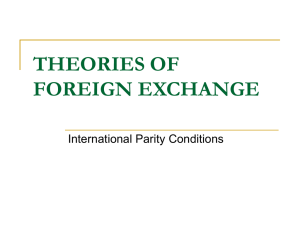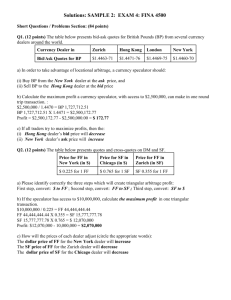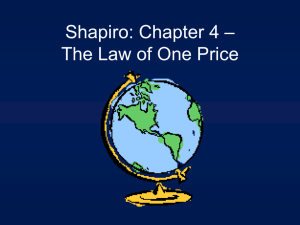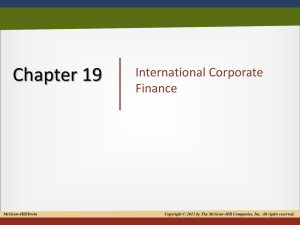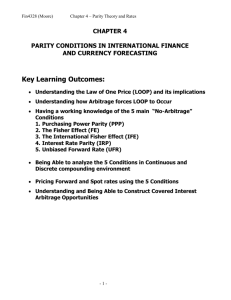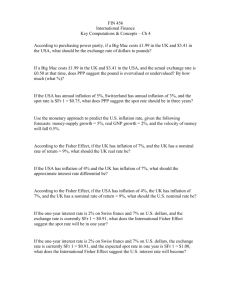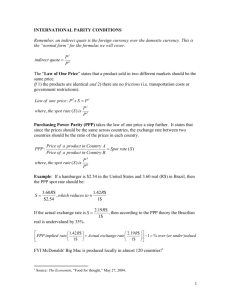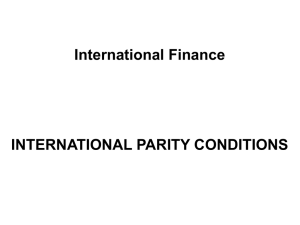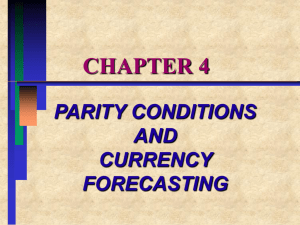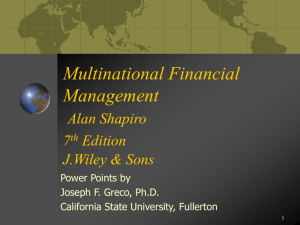Chapter 7 International Parity Conditions
advertisement
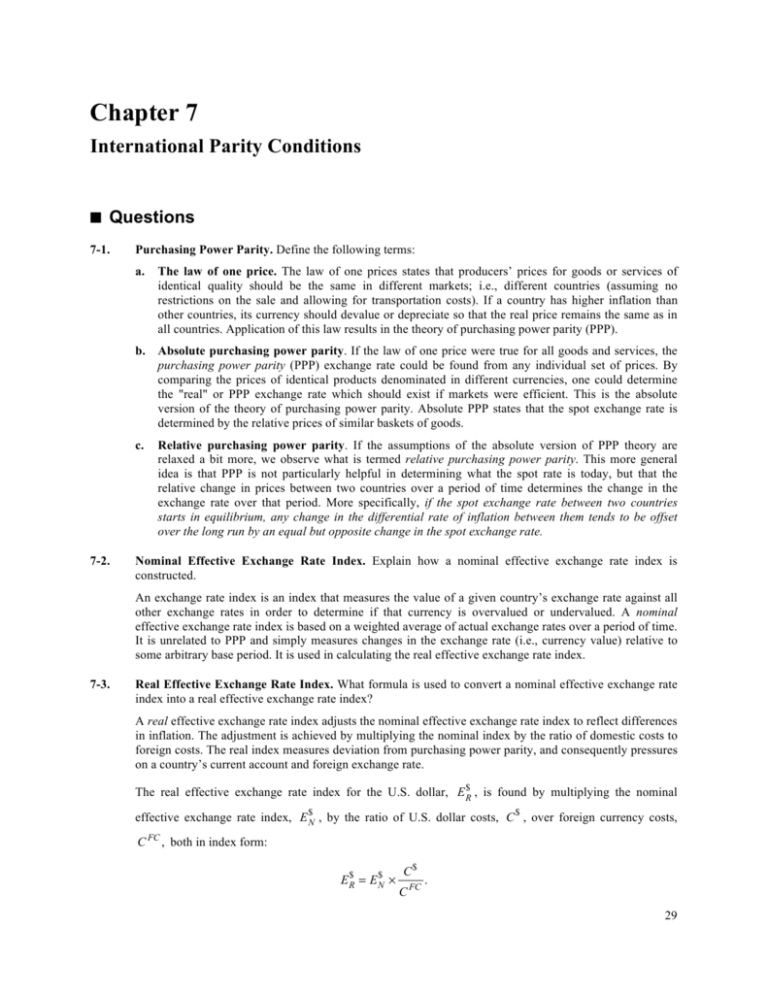
Chapter 7 International Parity Conditions ■ Questions 7-1. 7-2. Purchasing Power Parity. Define the following terms: a. The law of one price. The law of one prices states that producers’ prices for goods or services of identical quality should be the same in different markets; i.e., different countries (assuming no restrictions on the sale and allowing for transportation costs). If a country has higher inflation than other countries, its currency should devalue or depreciate so that the real price remains the same as in all countries. Application of this law results in the theory of purchasing power parity (PPP). b. Absolute purchasing power parity. If the law of one price were true for all goods and services, the purchasing power parity (PPP) exchange rate could be found from any individual set of prices. By comparing the prices of identical products denominated in different currencies, one could determine the "real" or PPP exchange rate which should exist if markets were efficient. This is the absolute version of the theory of purchasing power parity. Absolute PPP states that the spot exchange rate is determined by the relative prices of similar baskets of goods. c. Relative purchasing power parity. If the assumptions of the absolute version of PPP theory are relaxed a bit more, we observe what is termed relative purchasing power parity. This more general idea is that PPP is not particularly helpful in determining what the spot rate is today, but that the relative change in prices between two countries over a period of time determines the change in the exchange rate over that period. More specifically, if the spot exchange rate between two countries starts in equilibrium, any change in the differential rate of inflation between them tends to be offset over the long run by an equal but opposite change in the spot exchange rate. Nominal Effective Exchange Rate Index. Explain how a nominal effective exchange rate index is constructed. An exchange rate index is an index that measures the value of a given country’s exchange rate against all other exchange rates in order to determine if that currency is overvalued or undervalued. A nominal effective exchange rate index is based on a weighted average of actual exchange rates over a period of time. It is unrelated to PPP and simply measures changes in the exchange rate (i.e., currency value) relative to some arbitrary base period. It is used in calculating the real effective exchange rate index. 7-3. Real Effective Exchange Rate Index. What formula is used to convert a nominal effective exchange rate index into a real effective exchange rate index? A real effective exchange rate index adjusts the nominal effective exchange rate index to reflect differences in inflation. The adjustment is achieved by multiplying the nominal index by the ratio of domestic costs to foreign costs. The real index measures deviation from purchasing power parity, and consequently pressures on a country’s current account and foreign exchange rate. The real effective exchange rate index for the U.S. dollar, E R$ , is found by multiplying the nominal $ effective exchange rate index, E N , by the ratio of U.S. dollar costs, C $ , over foreign currency costs, C FC , both in index form: $ E R$ = E N ! C$ C FC . 29 30 7-4. Eiteman/Stonehill/Moffett • Multinational Business Finance, Thirteenth Edition Real Effective Exchange Rates: Japan and the United States. Exhibit 7.3 compares the real effective exchange rates for Japan, the United States, and the Euro area. If the comparative real effective exchange rate was the main determinant, does Japan or the United States have a competitive advantage in exporting? Which of the two has an advantage in importing? Explain why. Exhibit 7.3 shows that the real effective exchange rate has varied considerably from year to year for both the U.S. dollar and the Japanese yen, and the data lends some support to the concept that PPP may hold— even for the long run. For example, the index of the real effective exchange rate for the U.S. dollar rose considerably in the mid-1980s, with the Japanese yen doing the same in the 1990s. In each case the currency fell back to earth, or close to parity, after its divergence. In the 1980s and 1990s, the dollar and yen moved counter-cyclical to each other, but that has not been the case since 2000. In theory, a country with an undervalued currency should have a relative advantage in exporting over those countries suffering an overvalued currency. Similarly, an overvalued currency should lead to increased purchasing power for imports. 7-5. Exchange Rate Pass-Through. Incomplete exchange rate pass-through is one reason that a country’s real effective exchange rate can deviate for lengthy periods from its purchasing power equilibrium level of 100. What is meant by the term exchange rate pass-through? Incomplete exchange rate pass-through is one reason that a country’s real effective exchange rate index can deviate for lengthy periods from its PPP-equilibrium level of 100. The degree to which the prices of imported and exported goods change as a result of exchange rate changes is termed pass-through. Although PPP implies that all exchange rate changes are passed through by equivalent changes in prices to trading partners, empirical research in the 1980s questioned this long-held assumption. For example, sizable current account deficits of the United States in the 1980s and 1990s did not respond to changes in the value of the dollar. 7-6. The Fisher Effect. Define the Fisher effect. To what extent do empirical tests confirm that the Fisher effect exists in practice? The Fisher effect, named after economist Irving Fisher, states that nominal interest rates in each country are equal to the required real rate of return plus compensation for expected inflation. More formally, this is ( )( ) derived from 1+ r 1+ ! " 1 : i = r + ! + r! where i is the nominal rate of interest, r is the real rate of interest, and π is the expected rate of inflation over the period of time for which funds are to be lent. The final compound term, r times π, is frequently dropped from consideration due to its relatively minor value. The Fisher effect then reduces to (approximate form): i = r +! The Fisher effect applied to two different countries like the United States and Japan would be: i$ = r $ + ! $ ; i ¥ = r ¥ + ! ¥ In which the superscripts $ and ¥ pertain to the respective nominal (i), real (r), and expected inflation (π) components of financial instruments denominated in dollars and yen, respectively. We need to forecast the future rate of inflation, not what inflation has been. Predicting the future can be difficult. 7-7. The International Fisher Effect. Define the international Fisher effect. To what extent do empirical tests confirm that the international Fisher effect exists in practice? Irving Fisher stated that the spot exchange rate should change in an equal amount but opposite in direction to the difference in nominal interest rates. Stated differently, the real return in different countries should be Eiteman/Stonehill/Moffett • Multinational Business Finance, Thirteenth Edition 31 the same, so that if one country has a higher nominal interest rate, the gain from investing in that currency will be lost by a deterioration of its exchange rate. The relationship between the percentage change in the spot exchange rate over time and the differential between comparable interest rates in different national capital markets is known as the international Fisher effect. “Fisher-open,” as it is often termed, states that the spot exchange rate should change in an equal amount but in the opposite direction to the difference in interest rates between two countries. More formally: S1 ! S2 " 100 = i$ ! i ¥ , S2 in which i$ and i ¥ are the respective national interest rates, and S is the spot exchange rate using indirect quotes (an indirect quote on the dollar is, for example, ¥/$) at the beginning of the period ( S1 ) and the end of the period ( S2 ). This is the approximation form commonly used in industry. The precise formulation is: S1 ! S2 i$ ! i ¥ = . S2 1+ i ¥ Empirical tests using ex-post national inflation rates have shown the Fisher effect usually exists for shortmaturity government securities such as treasury bills and notes. Comparisons based on longer maturities suffer from the increased financial risk inherent in fluctuations of the market value of the bonds prior to maturity. Comparisons of private sector securities are influenced by unequal creditworthiness of the issuers. All the tests are inconclusive to the extent that recent past rates of inflation are not a correct measure of future expected rates of inflation. 7-8. Interest Rate Parity. Define interest rate parity. What is the relationship between interest rate parity and forward rates? The theory of interest rate parity (IRP) provides the linkage between the foreign exchange markets and the international money markets. The theory states: The difference in the national interest rates for securities of similar risk and maturity should be equal to, but opposite in sign to, the forward rate discount or premium for the foreign currency, except for transaction costs. 7-9. Covered Interest Arbitrage. Define the terms covered interest arbitrage and uncovered interest arbitrage. What is the difference between these two transactions? The spot and forward exchange markets are not, however, constantly in the state of equilibrium described by interest rate parity. When the market is not in equilibrium, the potential for “riskless” or arbitrage profit exists. The arbitrager who recognizes such an imbalance will move to take advantage of the disequilibrium by investing in whichever currency offers the higher return on a covered basis. This is called covered interest arbitrage (CIA). A deviation from covered interest arbitrage is uncovered interest arbitrage (UIA), wherein investors borrow in countries and currencies exhibiting relatively low interest rates, and convert the proceeds into currencies that offer much higher interest rates. The transaction is “uncovered” because the investor does not sell the higher yielding currency proceeds forward, choosing to remain uncovered and accept the currency risk of exchanging the higher yield currency into the lower yielding currency at the end of the period. Exhibit 7.8 demonstrates the steps an uncovered interest arbitrager takes when undertaking what is termed the yen carry trade. 7-10. Forward Rate as an Unbiased Predictor of the Future Spot Rate. Some forecasters believe that foreign exchange markets for the major floating currencies are “efficient” and forward exchange rates are unbiased predictors of future spot exchange rates. What is meant by “unbiased predictor” in terms of how the forward rate performs in estimating future spot exchange rates? 32 Eiteman/Stonehill/Moffett • Multinational Business Finance, Thirteenth Edition Some forecasters believe that foreign exchange markets for the major floating currencies are “efficient” and forward exchange rates are unbiased predictors of future spot exchange rates. Exhibit 7.10 demonstrates the meaning of “unbiased prediction” in terms of how the forward rate performs in estimating future spot exchange rates. If the forward rate is an unbiased predictor of the future spot rate, the expected value of the future spot rate at time 2 equals the present forward rate for time 2 delivery, available now, E S2 = F1. ( ) Intuitively this means that the distribution of possible actual spot rates in the future is centered on the forward rate. The fact that it is an unbiased predictor, however, does not mean that the future spot rate will actually be equal to what the forward rate predicts. Unbiased prediction simply means that the forward rate will, on average, overestimate and underestimate the actual future spot rate in equal frequency and degree. The forward rate may, in fact, never actually equal the future spot rate. The rationale for this relationship is based on the hypothesis that the foreign exchange market is reasonably efficient. Market efficiency assumes that a) all relevant information is quickly reflected in both the spot and forward exchange markets, b) transaction costs are low, and c) instruments denominated in different currencies are perfect substitutes for one another.
